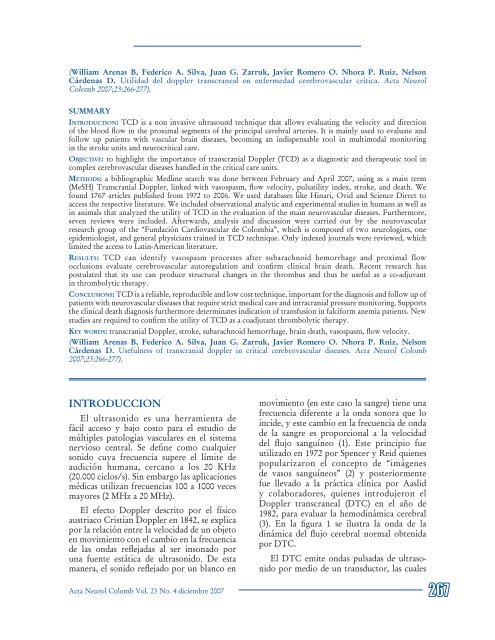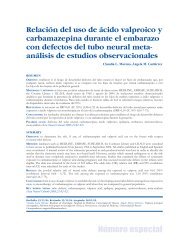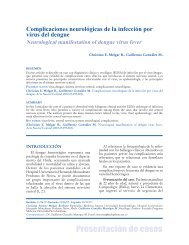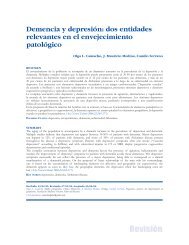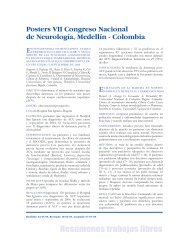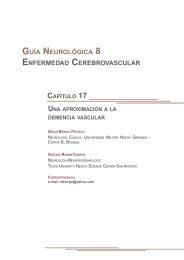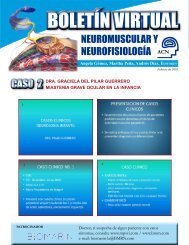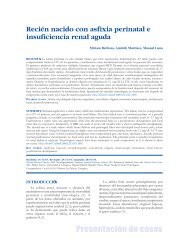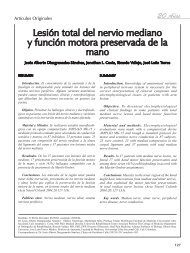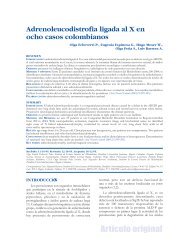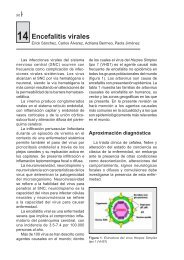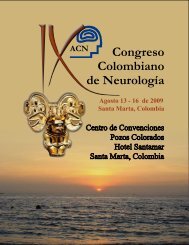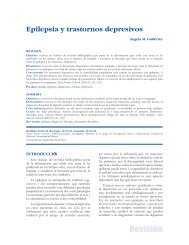Utilidad del doppler transcraneal en enfermedad cerebrovascular ...
Utilidad del doppler transcraneal en enfermedad cerebrovascular ...
Utilidad del doppler transcraneal en enfermedad cerebrovascular ...
You also want an ePaper? Increase the reach of your titles
YUMPU automatically turns print PDFs into web optimized ePapers that Google loves.
(William Ar<strong>en</strong>as B, Federico A. Silva, Juan G. Zarruk, Javier Romero O. Nhora P. Ruiz, Nelson<br />
Cárd<strong>en</strong>as D. <strong>Utilidad</strong> <strong>del</strong> <strong>doppler</strong> <strong>transcraneal</strong> <strong>en</strong> <strong>en</strong>fermedad <strong>cerebrovascular</strong> crítica. Acta Neurol<br />
Colomb 2007;23:266-277).<br />
SUMMARY<br />
INTRODUCTION: TCD is a non invasive ultrasound technique that allows evaluating the velocity and direction<br />
of the blood flow in the proximal segm<strong>en</strong>ts of the principal cerebral arteries. It is mainly used to evaluate and<br />
follow up pati<strong>en</strong>ts with vascular brain diseases, becoming an indisp<strong>en</strong>sable tool in multimodal monitoring<br />
in the stroke units and neurocritical care.<br />
OBJECTIVE: to highlight the importance of transcranial Doppler (TCD) as a diagnostic and therapeutic tool in<br />
complex <strong>cerebrovascular</strong> diseases handled in the critical care units.<br />
METHODS: a bibliographic Medline search was done betwe<strong>en</strong> February and April 2007, using as a main term<br />
(MeSH) Transcranial Doppler, linked with vasospasm, flow velocity, pulsatility index, stroke, and death. We<br />
found 1767 articles published from 1972 to 2006. We used databases like Hinari, Ovid and Sci<strong>en</strong>ce Direct to<br />
access the respective literature. We included observational analytic and experim<strong>en</strong>tal studies in humans as well as<br />
in animals that analyzed the utility of TCD in the evaluation of the main neurovascular diseases. Furthermore,<br />
sev<strong>en</strong> reviews were included. Afterwards, analysis and discussion were carried out by the neurovascular<br />
research group of the “Fundación Cardiovascular de Colombia”, which is composed of two neurologists, one<br />
epidemiologist, and g<strong>en</strong>eral physicians trained in TCD technique. Only indexed journals were reviewed, which<br />
limited the access to Latin-American literature.<br />
RESULTS: TCD can id<strong>en</strong>tify vasospasm processes after subarachnoid hemorrhage and proximal flow<br />
occlusions evaluate <strong>cerebrovascular</strong> autoregulation and confirm clinical brain death. Rec<strong>en</strong>t research has<br />
postulated that its use can produce structural changes in the thrombus and thus be useful as a co-adjuvant<br />
in thrombolytic therapy.<br />
CONCLUSIONS: TCD is a reliable, reproducible and low cost technique, important for the diagnosis and follow up of<br />
pati<strong>en</strong>ts with neurovascular diseases that require strict medical care and intracranial pressure monitoring. Supports<br />
the clinical death diagnosis furthermore determinates indication of transfusion in falciform anemia pati<strong>en</strong>ts. New<br />
studies are required to confirm the utility of TCD as a coadjutant thrombolytic therapy.<br />
KEY WORDS: transcranial Doppler, stroke, subarachnoid hemorrhage, brain death, vasospasm, flow velocity.<br />
(William Ar<strong>en</strong>as B, Federico A. Silva, Juan G. Zarruk, Javier Romero O. Nhora P. Ruiz, Nelson<br />
Cárd<strong>en</strong>as D. Usefulness of transcranial <strong>doppler</strong> in critical <strong>cerebrovascular</strong> diseases. Acta Neurol Colomb<br />
2007;23:266-277).<br />
INTRODUCCION<br />
El ultrasonido es una herrami<strong>en</strong>ta de<br />
fácil acceso y bajo costo para el estudio de<br />
múltiples patologías vasculares <strong>en</strong> el sistema<br />
nervioso c<strong>en</strong>tral. Se define como cualquier<br />
sonido cuya frecu<strong>en</strong>cia supere el límite de<br />
audición humana, cercano a los 20 KHz<br />
(20.000 ciclos/s). Sin embargo las aplicaciones<br />
médicas utilizan frecu<strong>en</strong>cias 100 a 1000 veces<br />
mayores (2 MHz a 20 MHz).<br />
El efecto Doppler descrito por el físico<br />
austriaco Cristian Doppler <strong>en</strong> 1842, se explica<br />
por la relación <strong>en</strong>tre la velocidad de un objeto<br />
<strong>en</strong> movimi<strong>en</strong>to con el cambio <strong>en</strong> la frecu<strong>en</strong>cia<br />
de las ondas reflejadas al ser insonado por<br />
una fu<strong>en</strong>te estática de ultrasonido. De esta<br />
manera, el sonido reflejado por un blanco <strong>en</strong><br />
movimi<strong>en</strong>to (<strong>en</strong> este caso la sangre) ti<strong>en</strong>e una<br />
frecu<strong>en</strong>cia difer<strong>en</strong>te a la onda sonora que lo<br />
incide, y este cambio <strong>en</strong> la frecu<strong>en</strong>cia de onda<br />
de la sangre es proporcional a la velocidad<br />
<strong>del</strong> flujo sanguíneo (1). Este principio fue<br />
utilizado <strong>en</strong> 1972 por Sp<strong>en</strong>cer y Reid qui<strong>en</strong>es<br />
popularizaron el concepto de “imág<strong>en</strong>es<br />
de vasos sanguíneos” (2) y posteriorm<strong>en</strong>te<br />
fue llevado a la práctica clínica por Aaslid<br />
y colaboradores, qui<strong>en</strong>es introdujeron el<br />
Doppler <strong>transcraneal</strong> (DTC) <strong>en</strong> el año de<br />
1982, para evaluar la hemodinámica cerebral<br />
(3). En la figura 1 se ilustra la onda de la<br />
dinámica <strong>del</strong> flujo cerebral normal obt<strong>en</strong>ida<br />
por DTC.<br />
El DTC emite ondas pulsadas de ultrasonido<br />
por medio de un transductor, las cuales<br />
Acta Neurol Colomb Vol. 23 No. 4 diciembre 2007


